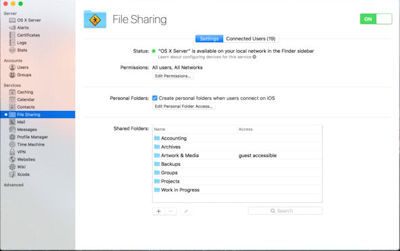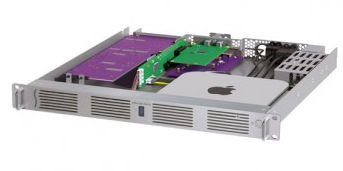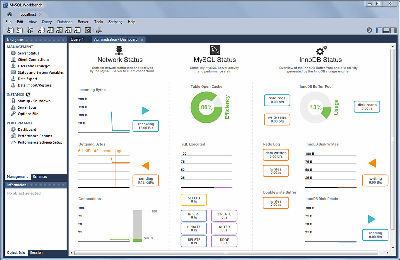Mac OS FAQ |
|---|
Updated: 1 August 2024
1. Does apple provide Mac OS Server?
You can download the latest mac os Server app version 5.12 applications from the App Store, for upto macOS Monterey.
Services include:
This includes Profile Manager performance inprovements, new restrictions for Unpaired external Boot to Recovery and Unlock with Apple Watch
and support for Xsan management.

2. Can I buy mac OS server hardware?
All current macs from the Mac Mini to the Mac Pro can be set up as a server.
There are third party rack mountable servers from Sonnet, based on the Mac Mini.

3. Can I set up Mac OS as a Web Server?
Yes, Mac OS comes with a web server called Apache which is can be enabled by starting the Apache web server.
The apache configuration can be found in /etc/apache2/httpd.conf file.
By default, any web pages are loaded from /Library/WebServer/Documents folder.
Control of apache is possible via the 'apachectl' (apache control) command. Run 'man apachectl' to view options for this command.
apachectl stop | start | restart | graceful - Stop and start the apache service. Required for any configuration changes.
If you want PHP code within your web site, then you may need to install PHP tool and enable the PHP module for Apache.
a) Enter 'sudo vi /etc/apache2/httpd.conf' to edit the file.
b) Press '/' and enter php to search for the php module line.
e.g. #LoadModule php7_module llibexec/apache2/libphp7.so
LoadModule
c) At the beginning of the line press 'x' to delete the '#' character.
d) Press ESC : wq to save and exit the file.
e) Enter 'sudo apachectl restart'.
For Monterey or later, you need to install PHP via homebrew or MacPorts, and enable PHP module and the module needs
signing for it to work with apache in macOS.
If you want to run Python cgi scripts, then follow these instructions on EditRocket.
4. Can I setup a MySQL database server on Mac OS?
Yes, there is a version of mySQL available from MySql.org which you can install on your Mac.
You should ideally add the mysql bin folder to your path to access mysql programs:
export PATH=/usr/local/mysql/bin:$PATH
The main mysql programs you can use are mysql, mysqladmin and mysqldump.
For managing your mySql Databases, I would recommend installing mySQLWorkbench.

If you organisation uses Microsoft SQL Server, you can manage your databases via the Azure Data Studio tool for Mac.
5. Can I run DNS on my Mac OS server?
Yes, Mac OS Server includes BIND which will allow you to resolve internet names to IP Addresses.
Alternatives include UnBound and KnotDNS.
If you do not have Mac OS Server, you could try installing the official BIND on Mac OS, you will need
access to HomeBrew, development tools (X Code), and this installation script to set it up.
See also these instructions to install BIND on Krypted.com.
6. Can I run DHCP on my Mac OS server?
Yes, Mac OS Server includes DHCP server which will allow you to allocate IP addresses to computer over a local area network.
Alternatively for a simple small network you can enable Internet Sharing from the Sharing System preferences, which will allow you
to share an internet connection from one computer to other computers.
Most modern ADSL modems, have a a built in DHCP server, you can use that rather than a dedicated DHCP server.
For larger networks, a dedicated DHCP server is required. So, you can try these instructions to install the DHCP service on mac os.
7. Can I run VPN (Virtual Private Network) from Mac OS?
Yes, Mac OS Server includes VPN which will allow you to connect to your local network over the internet.
An alternative solution called Open VPN , SoftEther and WireGuard is also available for Mac OS.
Ideally, use the VPN software supplied by your company to connect to their network.
8. Can I run virtual machines from Mac OS?
There are several products available to run virtual machines from mac OS including UMT, Parallels, Fusion, VirtualBox, and QEmu.
These are ok for for development or low-resources services, but for enterprise level virtualisation you need a dedicated service
such as VMWare vSphere or Windows Hyper-V services.
9. Can I run an Email or SMTP service on Mac OS?
Mac OS comes with Postfix for forwarding mail and can be used to send mail from a web site. See this article on setting up Postfix.
Alternatives include Courier mta and KerioConnect.
You can also configure another Email service called Exim4. See this article on setting it up.
For Calendar sharing try, Calendar Server. Other messaging service include ejabberd, Openfire and Prosody.
10. Can I configure Mac OS as a file and print server?
Yes, Mac OS can be used to share files and folders via Sharing in System Preferences.
Enable 'File Sharing' to enable file and folder sharing. You can share specific folders by clicking on the plus (+) button and add folders
and setup Read or Read and Write, or Write Only permissions for users. Users can be local users, Network user or from your contacts list.
To share printers, enable 'Printer Sharing'. You can configure Printers via the Printers & Scanners system preferences. Click on the plus (+) to select
the printer to share.
Printers can be a USB, Wi-Fi or network printer. You can specify a user from Users and Groups, Network Users or Groups, and from
contacts.
For more customisation of the printer, use the CUPS administration page to configure page size, colour and other options, from http://localhost:631.
If cups is disabled, you can enable it by opening Terminal and enter
cupsctl WebInterface=yes.
11. What can I use to manage many Macs?
If you need to deploy MacOS and applications to many Mac computers and manage settings and security then you need a project such as:
JamF Pro, Jamf Now and Jamf School. Jamf can provide deployment, device management, app management, inventory, self service and security.
Full details at Jamf.com .
Other tools include Microsoft InTune, Parallels Device Management, Apple Remote Desktop or the older Deploy Studio and Netboot.
12. What if MacOS is no longer viable as a server on my Mac?
You can replace macOS with Linux for your mac such as Ubuntu Server for x86/x64 bit or for ARM systems and use the wide range of server facilities.
It is also possible to install Windows Server on a Intel Mac like the Mac Mini.
Go to Classic Mac Systems